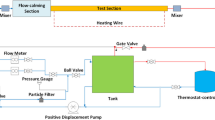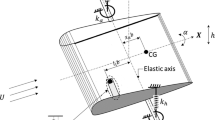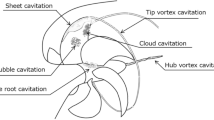Abstract
The orifice-induced wall pressure fluctuations and pipe vibrations are theoretically studied in this paper. The formulations of pipe vibration responses are deduced using acceptance integral approach. Based on the previous experimental results, the empirical equations of the power spectral density of the wall pressure fluctuations are developed, while the mathematical models of the cross-spectral density are generated when the longitudinal and circumferential correlation lengths and the convection velocity are determined. The modeling of the fluid excitations makes the finite element prediction of the orifice-induced pipe vibration responses become possible.
Similar content being viewed by others
References
U. S. NRC: Cavitation erosion of letdown line orifices resulting in fatigue cracking of pipe welds. Information Notice no. 98–45 (1998)
Mao, Q., et al.: High-level vibration and noise analysis of nuclear pipes with orifice. Transactions of SmiRT-17 paper # O02-6 1–5 (2003)
Website of Kansai Electric Power Co_ Mihama Power Station: Outline of incidents and failures occurred at NPPS in FY 2001
Chen, Z.: Root cause analysis and treatment of the leakage of the pipe welding after letdown orifice. Research of Nuclear Power Operation 16(2) (2003)
Mao, Q., et al.: Experimental studies of orifice-induced wall pressure fluctuations and pipe vibration. Int. J. Press. Vessels Piping 83, 505–511 (2006)
Powell, A.: On the fatigue failure of structures due to vibrations excited by random pressure fields. J. Acoust. Soc. Am. 30(12), 1130–1135 (1958)
Au-Yang, M.K.: Joint and cross acceptances for cross-flow-induced vibration – part I: theoretical and finite element formulations, part II: charts and applications. ASME J. Press. Vessel Technol. 122, 49–361 (2000)
Corcos, G.M.: Resolution of pressure in turbulence. J. Acoust. Soc. Am. 35, 192–199 (1963)
Durant, C., Robert, G.: Vibro-Acoustic response of a pipe excited by a turbulent internal flow. Flow Turbul. Combust. 61, 55–69 (1999)
Clinch, J.M.: Measurements of the wall pressure field at the surface of a smooth-walled pipe containing turbulent water flow. J. Sound Vib. 9(3), 398–419 (1969)
Au-Yang, M.K., Jordan, K.B.: Dynamic pressure inside a PWR - a study based on laboratory and field test data. Nucl. Eng. Des. 58, 113–125 (1980)
Au-Yang, M.K., et al.: Flow-induced vibration test of an advanced water reactor model, part 1: turbulence-induced forcing function. Nucl. Eng. Des. 157, 93–109 (1995)
Bull, M.K.: Wall-pressure fluctuations associated with subsonic turbulent boundary layer flow. J. Fluid Mech. 28(4), 719–754 (1967)
Willmarth, W.W., Wooldridge, C.E.: Measurements of the fluctuating pressure at the wall beneath a thick turbulence boundary layer. J. Fluid Mech. 14, 187–210 (1962)
Farabee, T.M., Casarella, M.J.: Spectral features of wall pressure fluctuations beneath turbulent boundary layers. Phys. Fluids A3(10), 2410–2420 (1991)
Author information
Authors and Affiliations
Corresponding author
Rights and permissions
About this article
Cite this article
Qing, M., Jinghui, Z. Orifice-induced Wall Pressure Fluctuations and Pipe Vibrations: Theory and Modeling of Fluid Excitations. Flow Turbulence Combust 79, 25–40 (2007). https://doi.org/10.1007/s10494-006-9062-2
Received:
Accepted:
Published:
Issue Date:
DOI: https://doi.org/10.1007/s10494-006-9062-2




